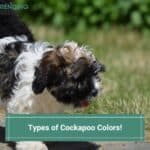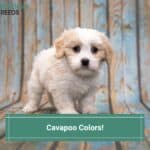
Cane Corsos make both menacing guard dogs and docile, loving family pets. The dogs become attached to their human companions and love spending time with them.
These gigantic dogs can make good hunting or protection pets. Their original Italian breeders preferred certain colors for various tasks.
Sometimes they wanted the dog to stand out. Other times they bred for colors that blended into the Italian countryside.
There are 12 different Cane Corso types, both common and rare. Let’s get into what you need to know about these amazing dogs.
Other articles you would like: Should You Crop Cane Corso Ears? and Cane Corso American Bulldog Mix Guide.
Table of Contents
Common Cane Corso Colors
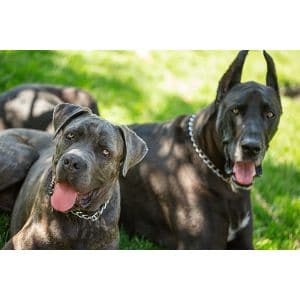
In the United States, the common Cane Corso colors coincide with the healthiest breeds recommended by the AKC (American Kennel Club). With rare breeds, some breeders focus on getting a certain color instead of a healthy dog.
Black Cane Corso

When they envision a Cane Corso, many people see the black variety. As guard dogs, the black coat makes this color the most intimidating. Although, most of these dogs grow to be quite large, bringing an intimidation factor all its own.
The eumelanin pigment is responsible for the deep black color of this Cane Corso coat. Many dogs have varying degrees of eumelanin in their coats. Some dogs have scattered black pigments broken up with other colors. Other breeds have larger segments of solid black.
The black Cane Corso has solid black pigmentation over the whole coat without specks. The black fur coat can invite health problems such as overheating.
The undercoat on these dogs tends to be thinner, possibly because of the threat of absorbing too much sunlight.
If you have a black Cane Corso, you may find that the dog enjoys cooler sunny days the most because the black absorbs more sunlight as the weather helps the dog regulate heat.
These dogs are so black that they seem to disappear at night. If you like walking after the sun goes down, invest in a reflective collar at the bare minimum. Including a vest with reflectors provides improved safety.
Fawn Cane Corso

You would not notice looking at the black variety, but many Cane Corsos have black masks. The mask is one of the hallmarks of the fawn variety, the most common color.
Sometimes gaining AKC acceptance with these dogs is difficult, but the club accepts every fawn color on the cream to brown Cane Corso spectrum. The mask should not go past the eyes, and white markings from the throat to the front legs are acceptable.
This breed, specifically the fawn-colored varieties, are ancient dogs thought to date back to the third century AD. Hailing from Italy and used as hunting dogs, the tan Cane Corso color blends nicely with the Italian countryside.
Fawn-colored parents are the most likely to produce the best offspring with coats of the right length that lack a silky sheen if you want a show dog. These details should not affect whether or not you will have a good guard dog.
Formentino Cane Corso

The Formentino Cane Corso straddles the line between common and rare. They are common because they are an offshoot of the widely accepted fawn variety.
Formentino means fermented wheat in Italian. The wheat color, lighter than the fawn color, describes the look of this Cane Corso. The specific color occurs due to a genetic mutation from the Fawn Cane Corso. The fawn color can have blue and gray tones.
This Corso variety can also have a distinct enough look for some people to describe them as a different breed. Fear not. The Formentino is still a Cane Corso. They are just rare and unique fawns.
Because of the lighter color, some skin conditions can arise. While they are not brindles, they can have some brindle-like markings of stripes or spots.
Unfortunately, lifespan is the main difference between a brindle and a Formentino. Formentinos live for about eight years compared to ten or more for a brindle.
Red Cane Corso
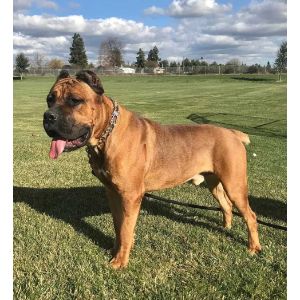
Because fawn-colored Cane Corsos are so common and look similar to the red variety, the reds are not common. The red Cane Corso also has a mask that can be gray or black.
Puppies might have blue or black saddle marks that fade as the dog matures. While red sounds are definitive, these dogs come in various shades. The variety can make these dogs difficult to classify.
The shades of red can resemble rosy, clear champagne or a deep color resembling mahogany wood. The pigment responsible for the color is the same in all the red colors, but the different genetic pathways produce variations.
You may also notice a white patch on the upper belly or lower chest. The patch does not affect whether or not your dog qualifies as a red Cane Corso.
Gray Cane Corso
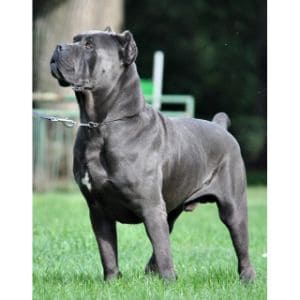
Though the fawn color is the most common, Cane Corso lovers search high and low for two other colors—black and gray. Cane Corsos are part of a large family of dogs known as Molossers, descendants of ancient breeds.
Cane Corsos are special because among Molossers, having a black and a gray variety is unique. The gray Corso is more difficult to breed than the black because both parents have to carry the recessive gene that creates the gray color.
To further complicate the odds of having a gray adult, puppies can look gray and mature to a slightly different color, like gray Brindle. True Gray Cane Corsos are uncommon and fetch an even higher price than most other varieties.
The gray color can also fade over time from sun exposure or from maturity alone. If you want a Corso protection dog, there is no good reason to go on the extensive hunt. Finding the gray variety would require. Focus on personality over looks.
Chestnut Brindle Cane Corso

For the first Brindle on the list, understanding what “brindled,” the root word, means is a good place to start. When you put the whole definition together, you get brown, brownish-orange, or gray mixed with stripes or spots of a darker color.
Chestnut Brindles and Black Brindles often look similar, and many have trouble distinguishing between the two. If you see a Brindle with this coloration, you are probably looking at the black variety because Chestnuts are uncommon.
You are more likely to see a Black Brindle because the Chestnut has a gene associated with coat color on a sex chromosome.
A gene of this type means the coloration of the parents can only produce a chestnut color if the dog is the right sex. You might have better luck rolling dice.
The Chestnut Corso variety can have a brown to red base color with reddish-brown stripes. The overall color resembles chestnut, but a lot is going on with the coloration patterns on the fur.
Black Brindle Cane Corso
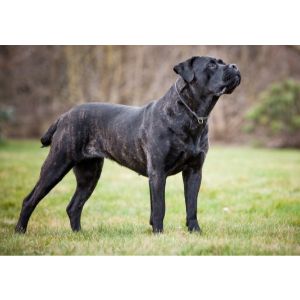
As we saw with the definition of brindled, the Black Brindle does not have a base color of black. The base is usually on the red-to-brown spectrum. There can be so many black stripes or spots overlaying the base color that the fur looks black.
The AKC recognizes the Black Brindle as an official breed. This dog also enjoys international recognition with the FCI (Fédération Cynologique Internationale) because its coloration and proportions match the overall requirements for a Cane Corso.
All Cane Corsos originally come from present-day Italy. The historical records indicate that people originally preferred certain colors for different tasks. The fawn color mentioned previously and the Black Brindle are two varieties people bred for hunting.
The tiger stripes and large jaws of this Brindle variety lend themselves to the hunting lineage these dogs seem to possess.
Italians describe these dogs as tigrato (tiger-like). As with all striped or spotted animals, the coloration resembles a fingerprint because no two are alike.
Gray Brindle Cane Corso

As you may have figured out, for a Cane Corso to qualify as a Brindle, regardless of color, the base must be reddish-brown. Darker stripes or spots overlay the base. The gray is no exception. The stripes can range from a blue to gray, making gray dominant.
The Gray Cane Corso is more common than the brindled variety, but unlike the true gray, the brindled gray is not as difficult to breed. There is no recessive gene magic that needs to happen. Two Gray Brindle Cane Corso parents typically produce a 50% gray litter.
As we have seen before, the old Italian Cane Corso breeders favored some colors for specific tasks. Horse breeders who drove the herd, similar to cowboys preferred the Gray Brindle.
We may never discover the true reason horse shepherds liked these dogs. The story goes that the gray stripes helped the dog blend in, and when predators tried to go after the horses, the dog seemed to appear out of nowhere and protect the herd.
The gray brindles often extend to the tip of the muzzle, and these dogs share the longer lifespan common to all brindled Cane Corsos.
Rare Cane Corso Colors

The phrase, rare Cane Corso colors, has two meanings. One, the standard meaning that a dog is not common. The less obvious reason is that the ATK does not recognize these variations as official Cane Corsos.
Due to potential health issues, some people will get suspicious and steer clear of a breed the ATK does not recognize. There are also plenty of scams lurking around.
Somebody might take an unusual-looking Cane Corso they got from uncommon parental breeding and try to convince you to pay more than what Cane Corsos are typically worth. A good rule of thumb is never to pay more than a typical Cane Corso price.
If you take the bait, you might overpay for a genetically inferior dog that drowns you in veterinary expenses.
Liver/Chocolate Cane Corso

While these dogs resemble the Red Cane Corso, the AKC accepts the Red as an official Cane Corso but not the Liver/Chocolate variety. Visually these dogs lack the coloration on the nose and around the eyes that the Reds have.
While still an attractive Corso dog, you risk buying an unhealthy animal due to breeding inferior genetics that favors appearance over desirable physical and mental attributes.
If you are in the market for a Cane Corso, I recommend verifying all paperwork and getting a second opinion before purchasing. AKC accepted Corso parents can breed and create unusually colored puppies.
Some breeders will take puppies that look different and give them off-the-wall names like Tri-Color Cane Corso, a dog that does not, officially or unofficially, exist.
Where the rubber meets the road is the price. Some unscrupulous breeders can name an odd-looking Corso puppy anything they want, but they cannot force you to overpay.
Never pay more than the going rate for these dogs because somebody claims the color increases its value.
Blue Cane Corso

When you find out there is a debate about whether or not Blue Cane Corso colors even exist, the reasons for the AKC’s refusal to acknowledge this variety become clear.
The AKC and other organizations make no mention of a blue color regarding any Cane Corso varieties.
A well-established fact in dog breeding is that enough breeders jumping on the bandwagon to prop up a new name for a breed can fool the public into thinking a new dog exists. This phenomenon may explain how the Blue Corso came into existence.
If you see a Blue advertised, you may be looking at a Gray Corso pup that came out lighter than its siblings with a blue tone due to a recessive gene.
Either way, the light color might indicate that the dog will develop a skin condition. Mange and CDA (Color Dilution Alopecia) are two likely candidates.
Isabella Cane Corso
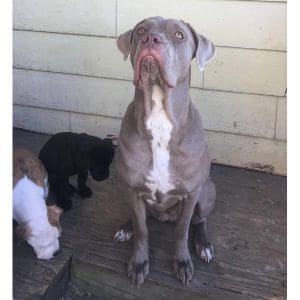
Unfortunately, some profit-driven breeders keep matching parents who produce Isabella Cane Corso pups, but this type of Corso commonly has health problems. Tawny, meaning brown to orangish-brown, is another name for the color of an Isabella.
These dogs can resemble Chocolate Corsos but are lighter in color. As we have seen with some other diluted Cane Corsos that are lighter in color, skin conditions like CDA may arise. Watch out for lots of scratching due to skin irritation. Hair loss may follow.
Isabellas will not have a black mask, and there may be a purplish-lilac color around the nostrils and eyes. Most of the common Corso varieties have black noses.
Straw Cane Corso
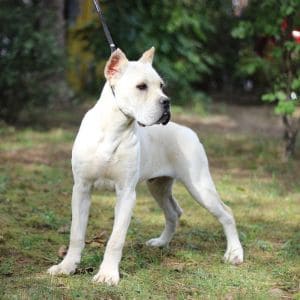
The Straw Cane Corso is the most controversial of the rare varieties. The reason is that in the old days in Italy if something like the AKC had existed, they would have accepted Straw Corsos as an official type.
Many farmers and communities sought the straw color specifically to guard stacks of hay stored during the winter.
Many animals tried to take shelter in the hay. People thought the straw color reflected highly flammable hay, matching the dog’s fiery personality.
Another reason people argue that the AKC, and other bodies, should accept the Straw variety is the long lives most dogs enjoy. People use White and Straw names to describe these dogs, but they are not albinos and have no associated health issues.
FAQs

Cane Corsos of many types and colors live virtually everywhere on Earth. Answering a list of definitive questions is impossible. If you want to do a deep dive into Cane Corsos, I recommend reading the expansive work of Dr. Flavio Bruno.
How many Cane Corso colors are there?
To answer how many colors Cane Corsos have, we have to address the fact that Cane Corso parents of the same color can carry recessive genes that cause them to have puppies of different colors. For the most part, we can ignore the results of abnormal genes.
Twelve types of Cane Corsos can have color variations between them, so the colors are almost infinite. Here are the types:
- Black Cane Corso
- Fawn Cane Corso
- Formentino Cane Corso
- Red Cane Corso
- Gray Cane Corso
- Chestnut Brindle Cane Corso
- Black Brindle Cane Corso
- Gray Brindle Cane Corso
- Liver/Chocolate Cane Corso
- Blue Cane Corso
- Isabella Cane Corso
- Straw Cane Corso
What is the rarest Cane Corso color?
One way to answer this question is to say that the Blue Cane Corso is the rarest because some people argue that this color does not exist.
The people who feel this way think Blues are Gray Cane Corsos that came out lighter in color due to the combination of unique genes.
Regarding the varieties that people agree exist, there is no number one rarest. The four rarest are the Straw, Isabella, Liver, and Chocolate. These four Corsos rely on recessive genes to occur.
Cane Corso Colors
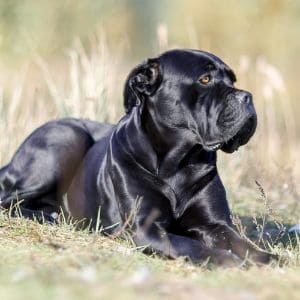
Rather than focusing on the color of a Cane Corso, I recommend seeking out the most desirable physical and mental traits.
Whether you need this unique dog to work or be a great family pet and fearless guardian, you need desirable personality traits and a healthy physique.
Carefully scrutinize breeders and get second and even third opinions. If you square all of these things away and still have a choice to make regarding color, by all means, pick your favorite. Just be sure you are getting a healthy dog from a quality lineage.
You will also like:
For more information about Cane Corso Breed, check out the video below:


